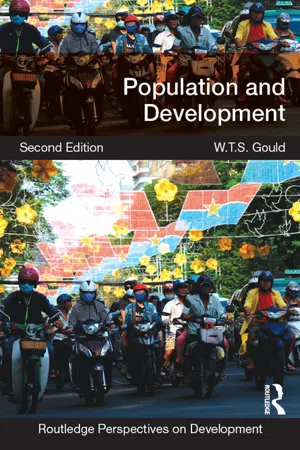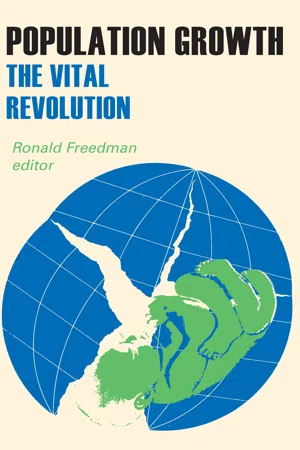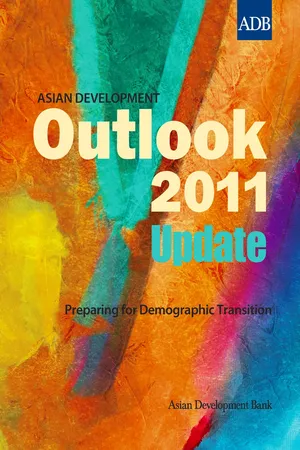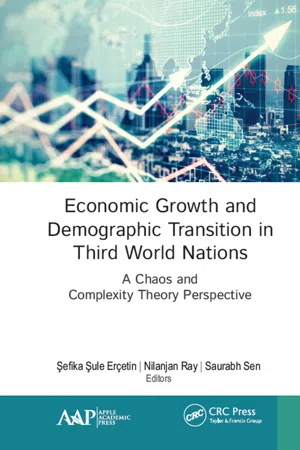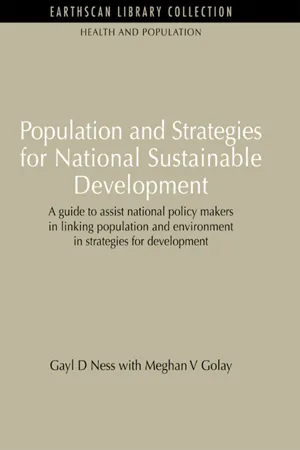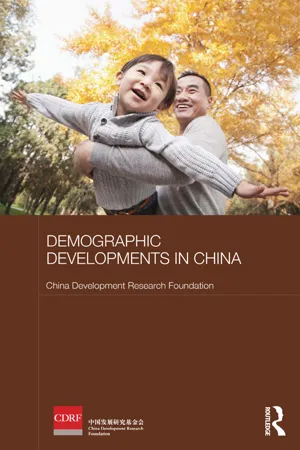Geography
Demographic Transition Model
The Demographic Transition Model is a concept that explains the population changes in a society as it undergoes economic development. It consists of four stages that represent shifts in birth and death rates, leading to changes in population growth. These stages help to understand how a society's population structure evolves over time in response to social and economic changes.
Written by Perlego with AI-assistance
Related key terms
10 Key excerpts on "Demographic Transition Model"
- eBook - ePub
- W.T.S. Gould(Author)
- 2015(Publication Date)
- Routledge(Publisher)
Demographic transition theory (DTT), however, is mostly recognised in terms of its descriptive manifestation, the Demographic Transition Model (DTM) (Clarke 1971; Reher 2004). The DTM is widely used as a descriptive framework for a great deal of population analysis, for Developing Countries as well as for Developed Countries. It summarises the Western experience of mortality and fertility change, and generalises this to a global description of successive stages of change. It is thus an empirical generalisation rather than a causal conceptualisation. It can assist analysts to set population change in any given national or regional or time-specific context, and it can suggest broad trends and relationships, but it is not able on its own to explain the theory: how and, more importantly, why population change proceeds.Figure 3.1 The Demographic Transition Model.The model is divided into four distinct chronological phases (Figure 3.1 ):• high equilibrium or homeostasis at very low population growth, in which mortality fluctuates at a high level to generate life expectancies of between 30 and 35 years, but fertility is fairly constant from year to year at a TFR of about five children per woman;• early expanding phase, in which the rate of natural population growth begins to accelerate as mortality falls, but fertility remains fairly constant at the levels of the high equilibrium period. In this period mortality falls and life expectancies at birth rise to over 55 years, fertility remains at its previous high levels and the growth rate may exceed 2 per cent per year;• late expanding phase, in which population is still growing but the rate of growth begins to fall. The rate of decline in mortality slackens, but continues. However, this period is characterised by rapid and substantial fertility decline, and the gap between mortality and fertility is progressively narrowed;• low equilibrium period, in which mortality, continuing to fall very slowly as life expectancies gradually rise to over 75 years, and fertility, at about a TFR of 2, just about replacement level for that of mortality, are in long-term equilibrium. Note, however, that short-run fluctuations in mortality are now less evident than short-run fluctuations in fertility. - eBook - ePub
Population Growth
The Vital Revolution
- Ronald Freedman(Author)
- 2017(Publication Date)
- Routledge(Publisher)
Chapter 2THE DEMOGRAPHIC TRANSITION: FROM HIGH TO LOW BIRTH RATES AND DEATH RATES George J. StolnitzDemographic transitions rank among the most sweeping and best-documented historical trends of modern times. The following discussion of transition patterns summarizes past declines of vital rates and the prospects for future ones in comparatively global fashion. Its focus is on modern population movements in broad terms, on major regions of the world rather than individual countries, and on some major implications only. Details will be kept in the background. It is important to keep in mind, therefore, that the general picture to be described is based upon hundreds of investigations, covering a host of specific places, periods and events. Indeed, it is the very multiplicity of these building blocks which accounts for the impressiveness of the over-all structure.The main outlines of the structure can be summarized briefly. All nations in the Modern Era which have moved from a traditional, agrarian-based economic system to a largely industrial, urbanized base have also moved from a condition of high mortality and fertility to low mortality and fertility. In so doing they have almost all experienced enormous increases in population along with massive shifts in their relative numbers of children, adults and aged. Partly as cause and partly as result have been associated sweeping changes in the relation between population and natural resources, in the relation between numbers of consumers and size of labor force, in investment patterns and in the distribution of people between rural and urban areas.To give these generalizations even skeletal form requires some perspectives. A first perspective is that the periods needed for maturation of the vital trends just outlined have not been short. Although they vary greatly from country to country and case to case, they have always been long-run, more like quarters of a century or generations than decades, and surely more like decades than single years. We need to remember this when considering the relevance of the experience in the industrialized nations for the underdeveloped economies of today. - eBook - ePub
Asian Development Outlook 2011 Update
Preparing for Demographic Transition
- (Author)
- 2011(Publication Date)
- Asian Development Bank(Publisher)
PREPARING FOR DEMOGRAPHIC TRANSITIONPreparing for demographic transition This chapter was written by Donghyun Park, Arief Ramayandi, and Gemma Estrada of the Economics and Research Department. It draws on the background papers listed at the end of the chapter.2
Introduction
Developing Asia is set to continue its steady growth in the near term. The region is, however, going through major structural shifts (such as rebalancing between exports and domestic consumption, and rising inequality), which impinge on its medium- and long-run growth prospects. One of these shifts concerns the “demographic dividend” (Box 2.1.1 ) that is now coming to an end for some of its largest economies—the drivers of regional growth.2.1.1 Three concepts This chapter refers frequently to three distinct but related concepts: the demographic transition, population aging, and the demographic dividend (or its opposite, the demographic tax).The demographic transition refers to the change from a high mortality-high fertility configuration to a low mortality-low fertility pattern. Because of improvements in public health, particularly in containing contagious diseases that affect children, mortality rates initially decline, which cause population growth rates to rise. In time, fertility rates gradually decline, thus slowing population growth rates.The demographic transition alters the age distribution of the population (also referred to as the population age structure). Initially, the proportion of young persons increases (generating a pyramidal age structure). As fertility rates decline, the modal age (that is, the age with the largest frequency) of the population increases with the age of the large cohorts.This change is referred to as population aging: technically, a rising median age (that is, the age that divides the population in half). This causes the age structure gradually to become uniform if women average about two births each, or to take the shape of an inverse pyramid if lower fertility persists. - eBook - ePub
Economic Growth and Demographic Transition in Third World Nations
A Chaos and Complexity Theory Perspective
- Şefika Şule Erçetin, Nilanjan Ray, Saurabh Sen(Authors)
- 2019(Publication Date)
- Apple Academic Press(Publisher)
The demographic transition theory is a well-known discussion topic on the human population phenomenon around the world. During a transition period, mortality declines, and, after some decades, fertility declines. This changes population growth rates, size, and age distribution, and the trend continues for many decades. Thus, demographic transition, along with growth, changes the structure of population.2.3 DEMOGRAPHIC TRANSITION THEORY
The demographic transition theory is curiously paradoxical. While there is no general agreement on its explanatory frameworks, it is constantly invoked as if there were. This is due, in part, to demography’s post-World War II desire to be a science and to establish a “grand theory” of population and fertility decline. Yet, even in this quantitatively based discipline, wider intellectual currents have intruded: postmodernism and cultural and anthropological explanations have recently entered the field. Short-term theory is now the order of the day.In 1937, Kingsley Davis (1908–1997), an early exponent of the theory, suggested that ultimately the reproduction of species is incompatible with an advanced industrial society. Thus, he established the major framework of the theory, which held that socioeconomic development and modernization are major causal forces. This element of the theory remains robust. In a 2006 volume titled Demographic Transition Theory, one of the most influential 20th-century exponents, John C. Caldwell, argued that in industrial societies, the old values essential to agricultural societies—strong family, virginity, loyalty, and legitimate births—are no longer necessary except as “social pacifiers.” Industrial societies and, even more, postindustrial knowledge economies need mobile, educated individuals unencumbered with babies and family ties.2.4 GLOBAL POPULATION SCENARIO
The global population scenario is an important feature to appraise a country’s demographic transition scenario as well its role in the world population. The world population in 1901 was 1.6 billion. It was 3 billion in 1960 and 5 billion in 1987, while in 1999, it was 6 billion. Every 12–13 years, 1 billion people are added. The birth rate decreased substantially during the 1990s. Increasing employment among women, urbanization, and rising literacy, as well as decline in infant mortality rate have been some major causes responsible for a growing desire for smaller families. Apart from this, the increasing awareness and easy availability of contraceptive devices have made it possible for the majority of the couples to attain a desired family size. - eBook - ePub
Population and Strategies for National Sustainable Development
Population and Strategies for National Sustainable Development
- Gayl D Ness, Meghan V Golay(Authors)
- 2013(Publication Date)
- Routledge(Publisher)
The Demographic TransitionsThe demographic transition - the movement of a population from high to low mortality and fertility - is one of the best known demographic observations (Notestein, 1945). It is not a theory, though many of its aspects are covered with theoretical dispute. It is an empirical observation, and a near universal one at that.There is unfortunately a common misperception that the demographic transition is a single and rather fixed transition. It is most important to note, however, that there are not one, but two demographic transitions, past and present, (Figure 7 ) and the policy and programmatic implications of this distinction are profound.If rapid population growth is a problem, which most people today agree it is, it is a problem that can be addressed. A combination of measures can be taken that can reduce fertility rapidly and raise the quality of life. These include education for women, effective primary health care especially for women and children in rural areas, high quality, clientcentred family planning services, and the promotion of women’s rights. It is largely the responsibility of governments to provide this range of basic social services. When they do, and when they act effectively, there are benefits for the environment, for economic development, and for individual welfare, especially for poor rural women and children. When governments do not provide these services, there are high costs for the environment and for popular welfare, especially for poor rural women and children.But to see clearly the role of social services and government responsibility, it is necessary to be clear about the character of the two demographic transitions. Figure 7 portrays some of this character.The past demographic transition took place in all of the currently industrialized countries, and the same broad pattern, with somewhat varying rates of change, occurred in all the industrialized countries. Birth and death rates declined from high (or natural) to low (or controlled). Mortality declined first, rather gradually, followed, after a period of up to a century, by a decline of fertility. The intervening period witnessed relatively high rates of population growth. Those rates slowed with the decline of fertility and now every industrialized country shows fertility at or below replacement levels (a total fertility rate of 2.1 - see below, p. 122).14 - eBook - ePub
- Béla Tomka(Author)
- 2013(Publication Date)
- Routledge(Publisher)
14 Another line of criticism targets the suggestion by the model of fixed patterns and irreversible development, whereas in real life, demographic processes do not necessarily bear these characteristics. A good example here is the resumed increase of fertility after a period of decline in post-Second World War Western Europe, or the deteriorating mortality rates in communist countries from the 1960s that interrupted decades of improvement. These phenomena are discussed in detail later.Taken at face value, demographic transition is a description of historical patterns of vital rates. However, description is interwoven with explanation of mortality and fertility changes, which proved to be especially controversial. Several proponents of the model suggest a strong association between the decline of mortality (especially infant mortality) and that of fertility. They argue that the fall in mortality leads to an increase in family size and thus in population size, which is a pressure for families and societies alike. Consequently, they would try to adapt to the new conditions by using birth control and decreasing their fertility. Therefore it is the decline of deaths that eventually causes a decrease in births. However, this single-factor explanation that considers only demographic factors (fertility and mortality) seems to be unsatisfactory. It fails to shed light on the differences in the twentieth-century population history of European countries, because, as is discussed later, shrinking birth rates have also been triggered by societal, cultural and other factors.Considering all this, it is not surprising that in its standard form the transition has practically not been observed anywhere in Europe. The starting conditions (fertility and mortality levels before the transition), the commencement of the transition, and the dynamics of the process diverged from the model. Some of the stages may have been missing, or, at least, the length of phases seems varied in individual societies.Mortality started to decline in the second half of the eighteenth century in Europe, and, as will be shown, this process has continued to the present day, first at an accelerating, then at a decelerating pace. Timing lags were significant even between the three pioneering countries, England-Wales, Sweden and France. In England and Sweden, disregarding short-term fluctuations, gains in life expectancy can be registered from around 1740, whereas in France, the starting point of the momentous change in mortality was around 1780. It took at least a century for the improvement initially achieved in North-West Europe to spread to the central, southern, and eastern regions of the continent. Considerable gains in life expectancy appear to have begun in about 1840 in the Netherlands, about 1880 in Italy and about 1900 in Spain.15 - eBook - ePub
- Stephan Feuchtwang, Hans Steinm????ller;;;(Authors)
- 2017(Publication Date)
- WSPC (EUROPE)(Publisher)
Chapter 4Demographic TransitionThe ‘demographic transition’ is from couples with many children to couples with few in most of a country’s population. Lower fertility rates are combined with lower rates of mortality, which means people live longer and more of their children survive. It is what economic historians argue occurred either prior to and as a precondition for, or at the same time as, the transition to a reasonably prosperous industrial capitalist economy. It is more than just the breaking out from the kind of demographic growth that produced what Mark Elvin called China’s high-level equilibrium trap because its main condition is security of income for the relatively poor. So it is more than simply the relief of the population pressure on land.It is an index related to those of ‘development’ such as income per person above the absolute poverty line and growth of Gross Domestic Product (GDP) per person providing that minimum, which is sufficiency of income and its security. But upper classes with high incomes do not necessarily, even with income security, have small families — they can afford many children. So all three indexes indicate lower fertility among the relatively poor. The precondition is the availability of waged work on a large scale with or without increased agricultural productivity. The long-standing resort to which peasant farmers have turned when their land is insufficient to feed the whole family is migration, which is either upland into as-yet uncultivated land or to work as landless labour for other, richer farmers, or to wage work or self-employed small-scale commerce in towns and cities, sending remittances home if possible. But none of these resorts and their availability are a sufficient condition for the demographic transition, as we will see. - eBook - ePub
- China Development Research Foundation(Author)
- 2014(Publication Date)
- Routledge(Publisher)
In the second half of the twentieth century, following on the initial drop in fertility rates in western European countries, virtually all developing countries saw a similar sharp decline in fertility rates. Between 1960 and 2006, while the global population increased, the world’s gross domestic product (GDP) per capita also increased by 2.4 times. The average fertility rate dropped over the same period from 5.4 in 1962 to 2.5 in 2006 (World Bank, 2008). Due to this significant decline in the fertility rate, it is now taking longer for world population to increase by one billion people, despite the large and expanding population base. That base is still growing, out of sheer inertia, and excessive population growth, on the one hand, remains a huge challenge for many low-income countries. On the other hand, population aging has become a prominent feature in many higher- and middle-income countries.General patterns of demographic transitionThe term ‘demographic transition’ refers to a shift in reproductive patterns of a population from ‘high fertility and mortality rates’ to ‘low fertility and mortality rates.’ International experience generally indicates that such transition progresses through three stages. The first is featured by a low natural growth rate (NGR), caused by both high fertility and high mortality rates. The second is featured by a high NGR, caused by high fertility and low mortality rates. The third is featured by a low NGR, caused by both low fertility and low mortality rates.Demographic transition is the result of a variety of socioeconomic factors that include levels of social and economic development, degree of material abundance, technological progress, ideological trends, cultural traditions, and so on. These influence fertility and mortality rates either directly or indirectly, leading to different combinations that affect population reproduction in varying ways at different stages. Naturally, a government’s population policies can accelerate or slow down demographic transition to a degree. Seen historically, however, government policies have little ability to reverse the process in any fundamental way.From the perspective of mortality rates, the dramatic increase in global population in the twentieth century is the unavoidable result of mankind’s social progress. The fundamental reason for the increase is not more births, but longer life expectancy. Mortality rates have declined significantly since the industrial revolution, with improvements in people’s standard of living, scientific and technological advances, and in particular the improvements in medical technology and public health. In the brief time of just one century, life expectancy has more than doubled on a global basis. In developing countries, it increased from 25 to 61 years, and in industrialized countries, it increased from 45 to 73 years (Lee, 2003).2 - eBook - ePub
Demographics
A Guide to Methods and Data Sources for Media, Business, and Government
- Steven H. Murdock, Chris Kelley, Jeffrey L. Jordan, Beverly Pecotte, Alvin Luedke(Authors)
- 2015(Publication Date)
- Routledge(Publisher)
Chapter 2 Basic Concepts, Definitions, and Geography of Demography As with any area of study, it is essential in demography to understand its basic concepts and the definitions of its key terms and to become familiar with the types of geographic areas for which demographic data are generally available. Knowing the jargon of demography and knowing the types of areas for which data can be obtained are essential first steps in knowing how to effectively use its data. In this chapter, we provide an overview of key concepts and definitions and examine the geographic bases used in demography and its applications. Basic Dimensions and Processes Given the definition of demography as the study of population size, distribution, and composition and of the processes that determine these, a logical place to begin in understanding demographic factors is to understand (1) what is meant by a population; (2) the three key dimensions of population–size, distribution, and composition; and (3) the three basic processes that determine population change–fertility, mortality, and migration. A population refers to the persons living in a specific area at a specific point in time. It refers to the aggregate, the group of people as a whole, in an area. As such, it has characteristics that are unique to an aggregate and are not just the sum of individuals’ traits or characteristics. For example, a population can have a death rate, birth rate, etc., but individuals are either alive or dead, have or have not been born. There is no death or birth “rate” for an individual - eBook - ePub
Exploring Environmental Issues
An Integrated Approach
- David D. Kemp(Author)
- 2004(Publication Date)
- Routledge(Publisher)
Box 4.2 , Population structure). To reach ZPG more rapidly, the reproduction rate would have to be reduced significantly below the 2.1 children per family normally considered to be the replacement reproduction rate. Despite this, there are nations in the developed world that have already reached or even surpassed the conditions associated with ZPG.STAGES OF WORLD POPULATION GROWTH
The pattern of world population growth is complex, but it has not been haphazard. It can be represented by a general model, which compares birth rate, death rate and the resulting population change. The model suggests that world population has gone through a series of sequential stages delineated as follows: (1) high stationary, (2) early expanding, (3) late expanding, (4) low stationary, (5) declining (Figure 4.7 ). This model of population dynamics, referred to as the ‘demographic transition’, was based on the European experience of population change during and following the industrial revolution (Molnar and Molnar 2000). Originally derived from the relationship between population and economic change, the different stages have been recognized in other areas where the European pattern of development has been introduced. Differences in timing within and between regions have to be considered, and the factors that have brought about progress through the various stages of the transition also vary with time and place. Although nineteenth-century technology in Europe and twentieth-century technology applied in the developing world were quite different, for example, both brought about the decline in mortality characteristic of the second stage of the transition.As with all models, the Demographic Transition Model is a simplified representation of a complex phenomenon, but despite its origins it is sufficiently flexible that it can be used to chart stages in worldwide population growth. In addition, passage through each of these stages is associated with socio-economic and (sometimes) cultural change and with the evolution of the relationship between society and environment.
Learn about this page
Index pages curate the most relevant extracts from our library of academic textbooks. They’ve been created using an in-house natural language model (NLM), each adding context and meaning to key research topics.
